-
Friends, our 2nd Amendment rights are always under attack and the NRA has been a constant for decades in helping fight that fight.
We have partnered with the NRA to offer you a discount on membership and Muzzleloading Forum gets a small percentage too of each membership, so you are supporting both the NRA and us.
Use this link to sign up please; https://membership.nra.org/recruiters/join/XR045103
You are using an out of date browser. It may not display this or other websites correctly.
You should upgrade or use an alternative browser.
You should upgrade or use an alternative browser.
Appropriate rear sight for Early Fowler?
- Thread starter jmac
- Start date

Help Support Muzzleloading Forum:
This site may earn a commission from merchant affiliate
links, including eBay, Amazon, and others.
Capt. Jas.
58 Cal.
- Joined
- Aug 19, 2005
- Messages
- 3,049
- Reaction score
- 1,352
There can be rifle type rear sights found on fowling pieces. I believe these were placed after the fact on earlier pieces to make a "fowler" into another type of firearm than it's original intended design. Cheap import fowling pieces could be had for much less than a rifle and they could be used as an all around cheap pot shooting meat gun with the addition of a rear sight. I believe many smoothe guns of later American manufacture were built with rear sights. I hesitate to call the latter a fowling piece though.
Many fowling pieces (proper) did have rear sighting helps but would not be like a fine rifle sight. If the desire is to be a fowling piece then a sighting groove on the breech as is seen on most British guns or similar design or a "winged" or "V" groove applied in the rear sight area as can be found on many early continental pieces.
Just saw you have a TVM. Some of those I have seen use a combo of rifle hardware and maybe a fowling gun trigger guard. I probably would not hesitate to throw a rear sight on it. Late 18th c. smoothe rifle.
Many fowling pieces (proper) did have rear sighting helps but would not be like a fine rifle sight. If the desire is to be a fowling piece then a sighting groove on the breech as is seen on most British guns or similar design or a "winged" or "V" groove applied in the rear sight area as can be found on many early continental pieces.
Just saw you have a TVM. Some of those I have seen use a combo of rifle hardware and maybe a fowling gun trigger guard. I probably would not hesitate to throw a rear sight on it. Late 18th c. smoothe rifle.
Fowler rear sights were generally low and unobtrusive, but come to think of it, so were most original rifle sights, very few stood more than 1/8" above the barrel. I've seen some which had just a burr raised with a chisel cut and a V notch filed into the burr.
I am more interested in the style of rear sight, not so much whether a rear sight would be appropriate. I know a full buckhorn would be incorrect for the piece, more appropriate on a plains rifle, but would a low profile partridge style such as found on some early Lancaster rifles fit ?
John
John
Capt. Jas.
58 Cal.
- Joined
- Aug 19, 2005
- Messages
- 3,049
- Reaction score
- 1,352
That should be fine. It's up to you.
I just finished looking a collection of early fowlers and found that either they didn't have a rear sight at all or they had a hollow in the top of where the breach meats the tang. Most of these hollows also had a line cut in the bottom with two or more lines cut at angles to the central line in a fan pattern. A round file should do the trick along with an engravers tool to make the line.
Many Klatch
69 Cal.
- Joined
- May 19, 2006
- Messages
- 3,498
- Reaction score
- 268
If you put a rear sight on your fowler you will not be able to compete in shoots as a smoothbore. NMLRA rules require a smoothbore to have no rear sight that rises above the plane of the barrel. If you are not going to shoot at any club shoots you can put whatever rear sight on that you want. If you are going to shoot with a club you probably will want to find out what their rules are.
I have deep notches in the tangs and an enlarged tang screw that function as rear sights on all of my smoothbore guns.
Many Klatch.
I have deep notches in the tangs and an enlarged tang screw that function as rear sights on all of my smoothbore guns.
Many Klatch.
Thank you for the reply but I have not shot in competition for 40 years. My purpose for this gun is hunting. Placing the most accurate, humane shot, with in the limits of the firearm, is my primary goal. I use this flintlock on turkeys, squirrels and deer, with PRB. I simply want a sight that would not look out of place on this fowler.
John
John
well, sights do look out of place on a fowler, generally, but I'll show you an exception so you can have some "documentation". This is an original, brass-barreled fowler in the Schoharie, NY Old Stone Fort Museum.
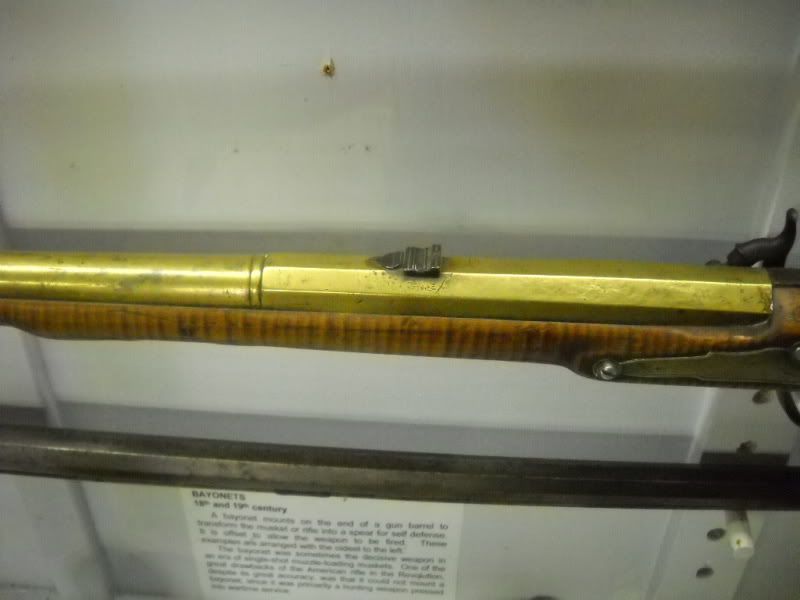
That ought to bring a smile to yer face.

That ought to bring a smile to yer face.
rich pierce said:well, sights do look out of place on a fowler, generally, but I'll show you an exception so you can have some "documentation". This is an original, brass-barreled fowler in the Schoharie, NY Old Stone Fort Museum.

That ought to bring a smile to yer face.
Yes, Yes it did... Germatic?
It is English styled and probably made on Long Island, New York or thereabouts, 1770's, near as folks who know better than me, can figure. This guesstimate is based on stock shape, carving around the tang and the sideplate. The gun is currently and may have originally been made as a halfstock and it has a wooden rib now.
But that's neither here nor there- it's a fowler adapted for militia use, with a rear sight plain as can be. :v
OK, I know you wanted to see more of it.
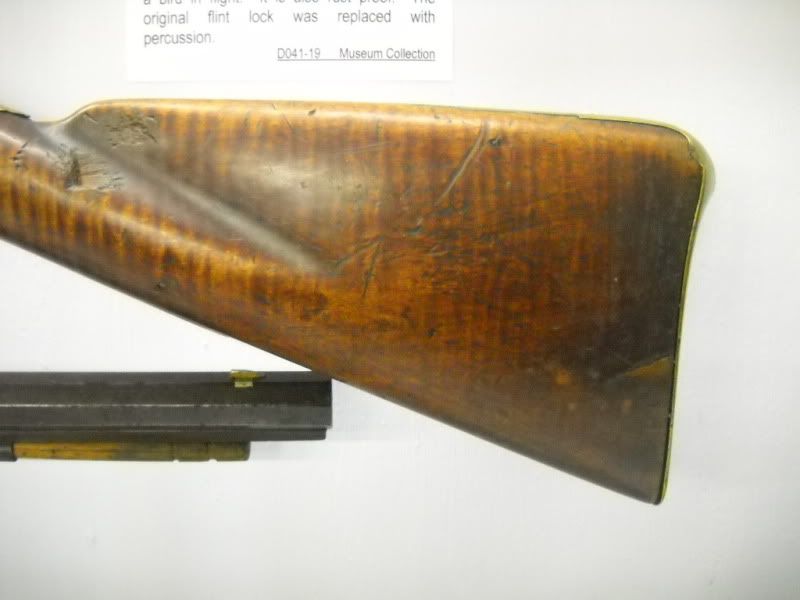
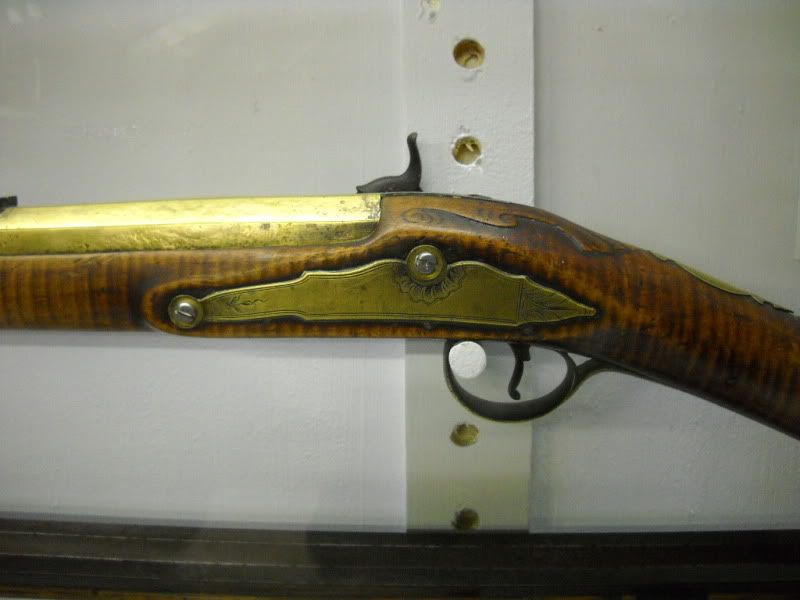

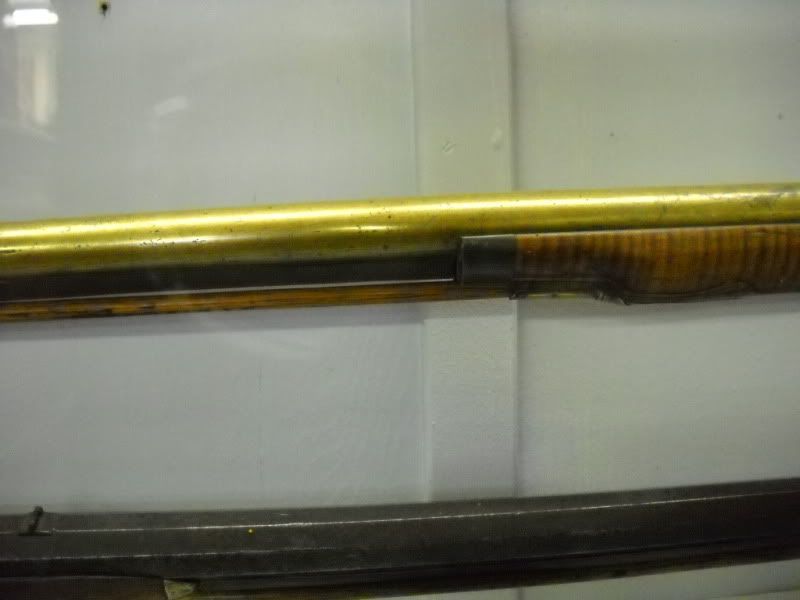
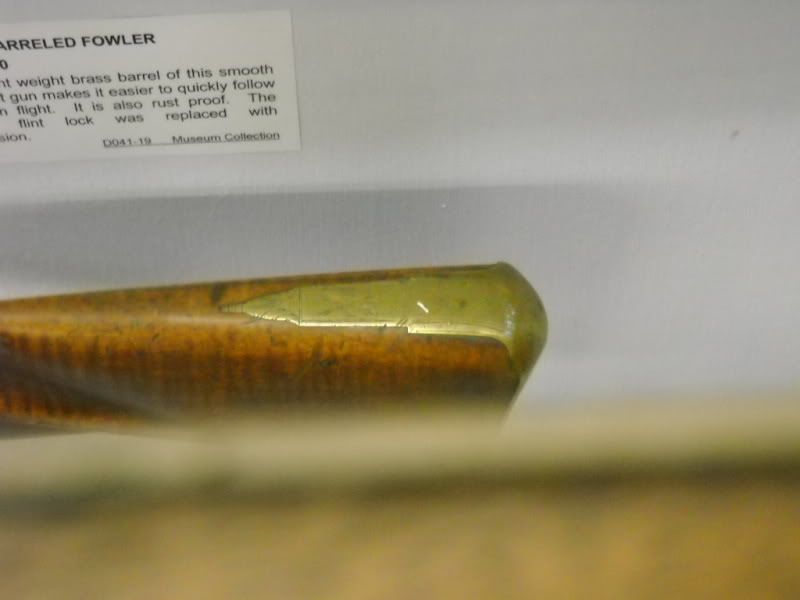
But that's neither here nor there- it's a fowler adapted for militia use, with a rear sight plain as can be. :v
OK, I know you wanted to see more of it.





Russ T Frizzen
70 Cal.
- Joined
- Nov 9, 2004
- Messages
- 5,007
- Reaction score
- 423
Hi Rich. Thanks for the photos--they really take me back in time! I once had a similar fowler only with an iron barrel. Mine was made in western Connecticut and was light as a feather. :thumbsup:
Russ T Frizzen said:Hi Rich. Thanks for the photos--they really take me back in time! I once had a similar fowler only with an iron barrel. Mine was made in western Connecticut and was light as a feather. :thumbsup:
Certainly could be from western Connecticut, with that wooden rib. Sure there was lots of interactions between gunsmiths in the region. Was the carving on yours similar?
Russ T Frizzen
70 Cal.
- Joined
- Nov 9, 2004
- Messages
- 5,007
- Reaction score
- 423
The carving around the tang area was nearly identical and the sideplate was also very similar. I think the trigger guard was about the same as was the tang on the butt plate. My stock was of plainer wood and may have been cherry--I just don't recall for sure. It was one of the nicest handling guns I've ever had and if I'd had any sense I'd never have let it go!
Many Klatch
69 Cal.
- Joined
- May 19, 2006
- Messages
- 3,498
- Reaction score
- 268
You just have to do what you can to get by. :wink: As I get older I need to be smarter than my competition because I sure can't keep up with them otherwise.
Many Klatch
Many Klatch
Guest
When assembling the information for "Success in the North American Fur Trade" this subject was brought up many times. I have several trade guns with crude rear sights as do several private collectors. The Museum of the Fur Trade has a half a dozen that Charlie thought were added by the local blacksmiths. In all our research (Charlie, Curly and my attempts) looking at over 100 manufacturer's invoices, bills to the trade, etc. we found no reference to a rear sight being available, not even as an option.
The crude sights that we had reference to are no more than a cut made on the barrel flat near the tang and rolled forward toward the muzzle. Then a notch had been filed into the rolled metal making a rear sight.
The pictures shown in previous posts show after market style sights and by the quality of the sight fixture they were probably installed by a more skilled craftsman like a gunsmith. My two cents.... :hmm:
The crude sights that we had reference to are no more than a cut made on the barrel flat near the tang and rolled forward toward the muzzle. Then a notch had been filed into the rolled metal making a rear sight.
The pictures shown in previous posts show after market style sights and by the quality of the sight fixture they were probably installed by a more skilled craftsman like a gunsmith. My two cents.... :hmm:
Similar threads
- Replies
- 26
- Views
- 3K



